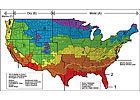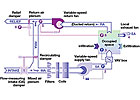
FIGURE 1. Climate zone chart. Courtesy of ASHRAE.
I have to admit, I’ve never seen the movieA Streetcar Named Desire, but I think most of us know that scene when Brando bellows, “Stella ... .” Frankly, I don’t even know who Stella is or why he is yelling for her, but it’s a safe bet that in the New Orleans of the 1950s, whoever Stella was, she probably heard the guy yelling from the courtyard through her open window. Today, I doubt she would. With the advance of air conditioning across the American South, fewer windows are open.
And what do you get when folks stay inside their hermetically sealed temperature controlled environments for longer periods? For one, you get a semi-captive audience that can be subjected to any bug or bacteria that might fester within those confines. And in the South, that bug is mold.
Mold didn’t just show up in the last 50 years. Mold and moisture in southern climes have always been with us. The difference is now southerners are spending most of their time indoors where we (those of us in the building community) have too often created conditions that foster and exacerbate mold growth, and then we efficiently distribute said toxin to the building’s inhabitants via the HVAC systems.
In short we have all the factors necessary for the perfect IAQ storm: people, pathogens, and pathways.
How Far North Is South?
Now before I go too far, I want to say that every HVAC project in every part of the country has moisture issues. It can be too much or too little. Perhaps it is in the building trying to escape, or outside the building trying to get in. But before you think moisture isn’t a concern on that project in a “dry” locale like Minneapolis or Phoenix, you better revisit your psych chart. If you aren’t thinking about sensible and latent load on every project, you’re being about as thorough as my son taking out the trash - not very.So where exactly is the “South” when we talk about those parts of the country with a higher propensity for moisture infiltration? Surprisingly (at least to me), ASHRAE doesn’t have a simple and satisfactory definition. For example, if you refer to ASHRAE Standard 90.1-2004, Appendix B, the warm-humid demarcation line on the climate zone map runs south of places we intuitively know have moisture issues like Atlanta or Charlotte, NC (Figure 1).
On the other hand, the map defines all of the U.S. east of the Rockies as “moist” (Climate Zone A), which to the inexperienced engineer might sound like areas where moisture would be a problem. But that area extends too far north. Where then is the delineation? Well, like anything in engineering, it requires a little more than referencing a map or table. It requires some intuitive reasoning.
Sticking with the 90.1 Standard, we see that economizers are not required in certain parts of the country (Table 6.5.1). This is predicated on the logic that in many locations there aren’t enough hours at the necessary conditions to support the added cost and complexity of an economizer operation. Simply put, most of the time it’s too nasty outside to help us inside.
Extending this logic to our moisture question, it is fair to say that if the conditions generally can’t help us, then they likely can hurt us and be problematic for the envelope and systems. Applying this more instinctive approach, our area of consideration expands from Climate Zones 1A, 2A and parts of 3A, to now include all of Climate Zone 3A and the border region of Zone 4A.
What led me to this expansion of the warm-humid zone of consideration was my own experience working in the Midwest. Specifically, the summers in St. Louis are brutal and rival the worst conditions in areas defined as warm-humid by ASHRAE. For example, the St. Louis 0.4% design dehumidification dewpoint is 76.9°F. Compare that to Miami with an equivalent design dewpoint of 78.0°1.
Of course, no one will confuse St. Louis with Miami in January (4.3° vs. 46.3° at 99.6% heating design) and the moisture in Florida is almost always driving into the building, while in St. Louis the drive reverses in the winter. The point is that the problem can manifest itself in Zone 4A, albeit for a shorter period and to a lesser extent. So as a border zone, it merits more evaluation than the other colder and drier zones to the north and west.

FIGURE 2. Comfort zone psychrometric chart. Courtesy of ASHRAE.
Mold Mechanics
When we speak of mold, we are actually talking about mildew, mold, fungi, and other forms of microbial growth. Mold by this definition is a living microorganism. The following four conditions must be present for mold to grow:- A source of spores
- A food source (normally organic material)
- Adequate moisture (point source or an rh greater than 70%)
- Temperatures between 40° and 100°
We can’t fight Mother Nature and the spores will always be with us. And although we have very little influence on the architectural building materials, there is the issue of our own duct insulation material. When it comes to lined duct, there are liner products with an anti-microbial agent, but even those products have disclaimers. I don’t like something I can’t easily see in the airstream that could collect moisture or mites. So I’ll go old school: avoid the possibility of problems over the life of the systems and either use double-wall ductwork or externally insulate.
Regarding moisture, when I referred to a point source, I was suggesting something like a leaking pipe, a leaking roof, or some other unfettered source of water into the envelope. These types of sources are the function of the building’s architectural design and quality control during construction. As systems designers, we have very little direct control over either. But when it comes to the envelope design, we should at least be educated.
Going Inside
Regarding temperature and humidity within the space, the recommended space conditions for a building in the South are no different than those recommended anywhere else in the country (Figure 2). Although theASHRAE Humidity Control Design Guidenarrows the high limit to a 57° dewpoint2, when working in the South I would suggest a 55° limit.I would also recommend limiting space conditions to those within the 0.5 “Clo hatched area,” representing the “summer” clothing insulation value. And realistically, in a commercial environment, trying to maintain less than a 50% rh is probably not only difficult to do, but just a waste of energy. With these additional parameters applied (see blue shaded area in Figure 2), 75° at 55% rh is about as cold and relatively humid as you should allow, with 75° at 50% rh ideal. Overcooling is not necessary and could in fact be detrimental.
Once we have determined the acceptable indoor rh, the question now becomes how do we get to and maintain that critical parameter.
Pressurization and dehumidification are the keys to moisture control for mechanical designers. In the simplest terms, we need to judiciously control where the air enters the building, wring the moisture out, and shuttle it to and from the spaces properly. We need to do this at peak and off peak, and regardless of whether the building is occupied or unoccupied.
Don't Push The Envelope
In the course of my career, I have found myself on the wrong end of a phone call more than once. For example an angry building owner calls to share that he has a lobby that can be likened to a rain forest due to condensation on the ductwork or diffusers. The user is convinced it is a mechanical problem because the trouble started when the A/C was turned on and it’s the mechanical stuff sweating. Never mind that the building systems haven’t been balanced yet, the doors are open, and you can see daylight when you poke your head above the ceiling.Ultimately, it may very well be a mechanical problem, but you as the engineer should be aware of some architectural issues before you fall on your sword. Understanding the dynamics even if you can’t draw the details will help you when problems arise. In the most basic terms, there are two things an envelope should do: Retard moisture and air entry into the building and, if moisture does accumulate, either drain to the exterior or evaporate.
I can’t tell you with authority how to design a wall, nor do I think you should try to on your own. That’s the architect’s responsibility. What I will do, however, is point you in the direction of a number of articles written by Joseph Lstiburek, Ph.D., P.E. in theASHRAE Journal. I could footnote all of his works, but I suggest simply doing a search by author at the ASHRAE website atwww.ashrae.org.
In addition, Lstiburek is a co-author ofASHRAE Humidity Control Design Guide for Commercial and Institutional Buildings, another incredible source for information regarding envelope design and issues.
The one thing I am qualified to tell you is never to rely on conventional wisdom when discussing envelope design. And don’t believe the old chestnut that “vapor barriers go on the warm side of the insulation.”
Number one, many grades of vapor barriers, vapor retarders, and weather barriers exist, and they all have differing characteristics. Second, nothing is as simple as “put it on the warm side.” Building geometry, weather conditions over the course of a year, exposure to sunlight and various other factors determine what kind of barrier or retarder applies and where it should go.
If you really want to have fun (and learn a thing or two), download the free WUFI ORNL/IBP moisture modeling program from the Oak Ridge National Lab website atwww.ornl.gov/sci/btc/apps/moisture/index.html. In some cases, as the program simulates a wall’s moisture characteristics over a year, you can get downright seasick watching the flow go back and forth.

FIGURE 3. Return fan setup. Courtesy of The Trane Company.
Pressurization
We have to bring ventilation air in to meet ASHRAE 62.1. We have to provide makeup for the air that is exhausted through toilets and storage rooms. And we have to create conditions where air is exfiltrating through the envelope instead of infiltrating. This air balance is absolutely critical to the success of the building. Even a properly designed and installed envelope is no match for a building under negative pressure.ASHRAE Guideline 16, Selecting Outdoor, Return and Relief Dampers for Air Side Economizer Systems provides some very good direction regarding damper and fan control to maintain correct building pressurization. Even though economizers are rarely effective in the South, the control sequences described can be simplified and still apply.
If you have a simple building and small system, there may be no need for a relief or return fan. But with most systems, especially systems that must maintain building pressures, the use of one or the other is required. There are arguments for and against both set-ups, but since I prefer ducted returns in humid climates (which will be explained later), and since they typically have higher static pressure on the return side (which merits a return fan), I will only discuss the return fan configuration herein (Figure 3):
- A flow sensor monitors intake airflow to maintain the proper volume of outdoor air for ventilation. The recirculating damper shares the same actuator and strokes opposite the outdoor air damper.
- A pressure sensor monitors supply duct static pressure and modulates the supply fan.
- The thermostat in each occupied space modulates the supply airflow to the space.
- Local exhaust fans (toilet rooms, storage, etc.) remove some of the air from the occupied spaces, and the remaining air exfiltrates.
- A pressure sensor in the AHU return air plenum modulates the return fan to maintain a sufficient positive pressure in the plenum to over-come the pressure drop of the return and/or relief dampers.
- And, a differential pressure sensor monitors the building pressure difference relative to the outdoors, and modulates the relief damper, in turn directly controlling building pressure.
By decoupling the supply fan from the return fan, we are ensured that they will maintain the pressures required in the supply duct and in the building, respectively. Fan tracking alone in an active building may not accomplish this.
What isn’t addressed here is the impact of demand-controlled ventilation, but one can see that the outdoor air intake is also decoupled from relief and return. So while the system is more dynamic, the return fan and relief damper are still controlled off building pressure alone.
In particular, as less outdoor air is introduced, the building becomes less positive and the relief damper throttles back in response. In turn, static pressure in the AHU return plenum increases. Consequently, the return fan slows down to decrease the pressure, and in so doing pulls less air from the building and avoids pulling it negative.
Until Next Time
Well, that about wraps it up for Part 1. I hope you have a better idea of why mold is a problem and how it thrives. We have expanded the ASHRAE definition of “hot-humid” to include parts of the country we might not have considered otherwise. And we have touched on the envelope and hopefully recognized that it is not to be taken lightly.On the mechanical front, we see that the definition of acceptable indoor conditions in the South are not that different from the North. It’s the stuff outside that makes all the difference, and we have discussed ways of keeping that stuff on the outside via pressurization and controlled intake.
In Part 2, we will discuss how to dehumidify that outdoor air so that we don’t create problems when we distribute it through the building, and we will look at that distribution and the importance of pushing and pulling that air into and out of the right places. Lastly, we will touch on the importance of a plan, from schematic design through commissioning.
Between now and then I think I’ll rent that Brando movie I mentioned and find out who the heck Stella was. I’ll let you know what I learn.

